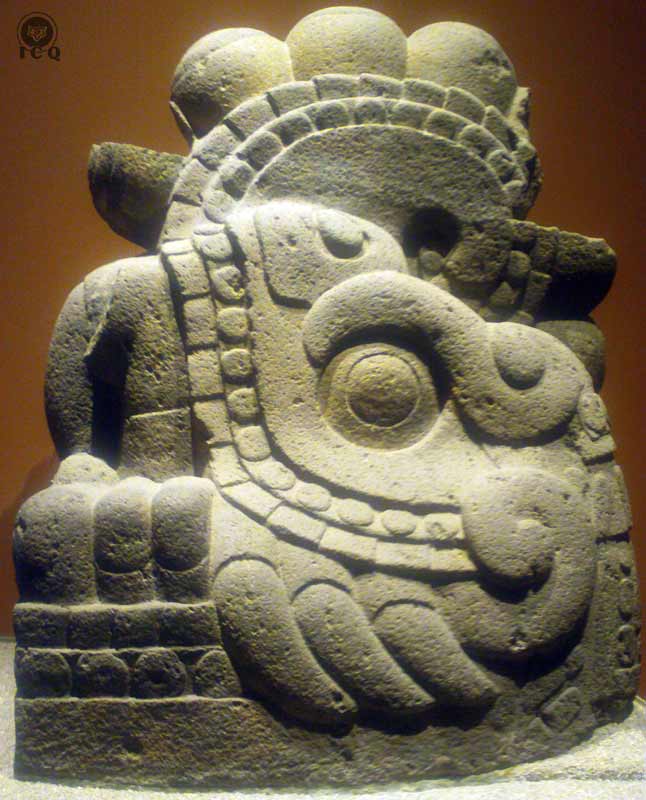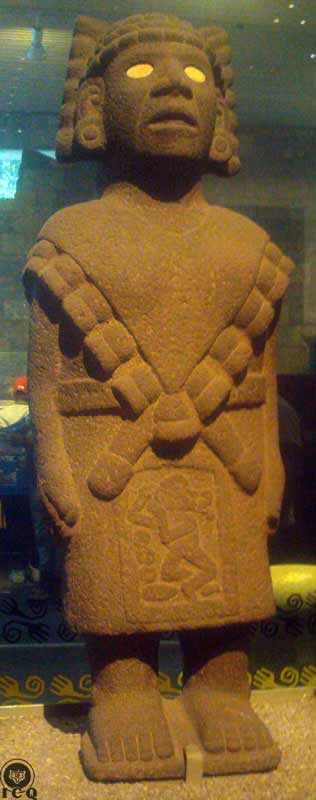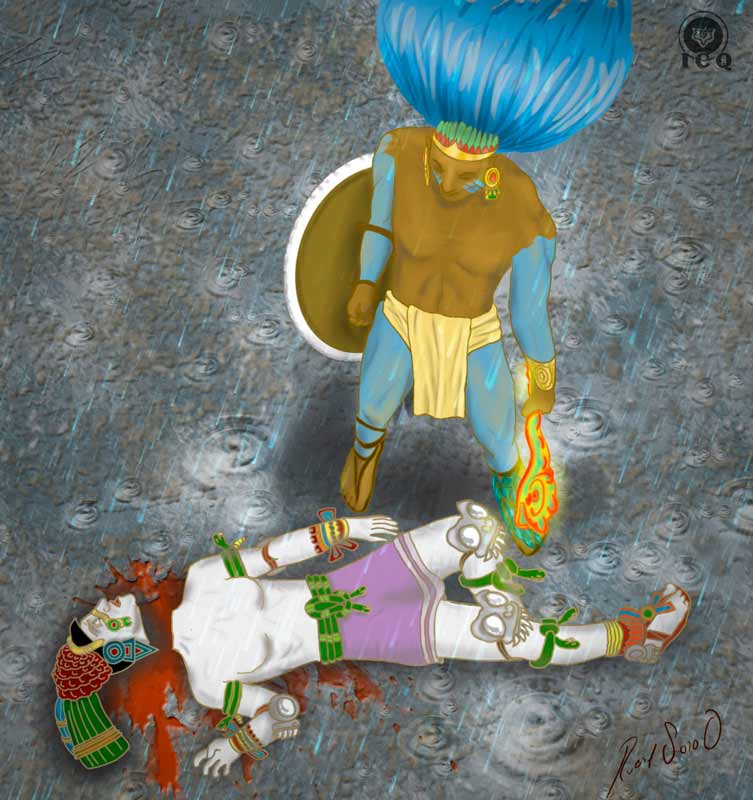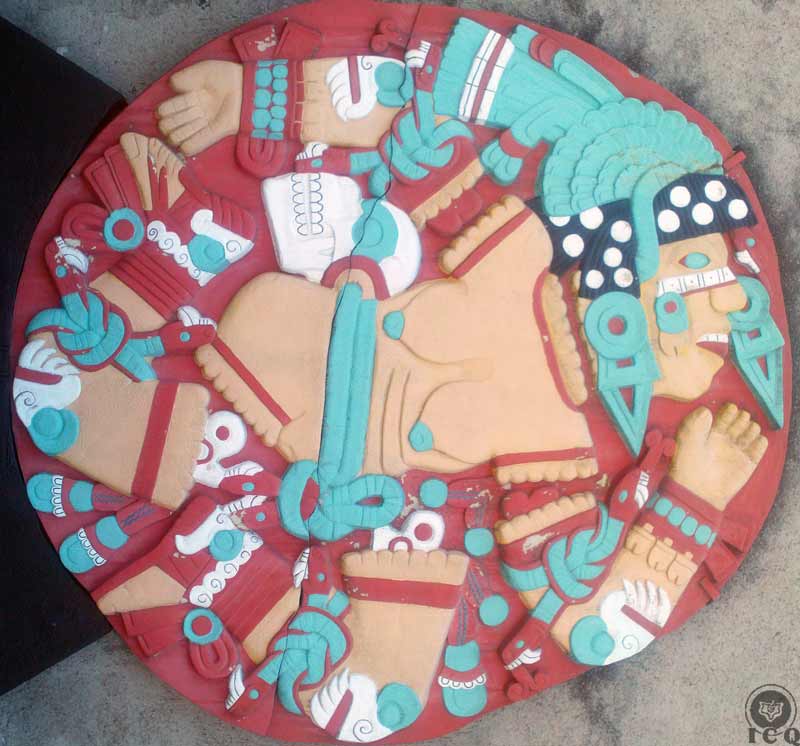The Birth of the Left-Handed Hummingbird [Huitzilopochtli]
Chapter 7 – The Serpent of Fire [Xiuhcoatl]
From the most ancient times all of the great cultures of the world have worshipped fire, but it must be noted that the worship is not to be taken literally as a worship to the fire that can be used to prepare a meal, or perhaps to the fire that comes with lightning but rather, the fire that exists in potentiality, in a latent state within our occult anatomy.

"Serpent of Fire" [Xiuhcoatl] (Museum of History and Anthropology, Mexico)
"And the one whose name was Tochancalqui set fire to a serpent made of firebrands called Xiuhcoatl, which obeyed Huitzilopochtli." Florentine Codex
By now the story has transitioned into an important aspect of the internal work, which is the use of the sacred fire or the "serpent of fire" [Xiuhcoatl] to increase our capacity to exterminate the ego.
There are significant similarities between the Kundalini serpent of the Hindis, the Winged Serpent of the Egyptians and Xiuhcoatl, the serpent of fire of this story.
This is a very special fire that is associated to our individual and particular Divine Mother, "our venerated mother" [Tonantzin], "mother of the Gods" [Teteoinan]. Our Divine Mother manifests in five different ways and one of them is her expression as the fire contained within the chakra of the coccyx, known as the Chakra of the Foundation or MULADHARA. She appears as a serpentine fire and this is why various cultures represent it in the same way.

"The Mother of the Gods" [Teteoina] (Museum of History and Anthropology, Mexico)
This is a fire that can only be awakened by practicing the superior ritual of the magic of love within the bond of matrimony, which is why there is a need for an additional, active character in this myth: Tochancalqui or "the one who inhabits our dwelling". It is this one "who inhabits in our dwelling" [Tochancalqui] who lights the serpent of firebrands, meaning that it is only in our home, in matrimony, when we truly have learned to love, that this fire will awaken.
This is why the path of the Revolution of the Consciousness is also known as the "Path of the Domestic Hearth"; it is in our home where we find the secret to liberation.
Those who are capable of awakening this sacred fire and who learn to control it, can direct it against the very psychological aggregates and destroy them – provided the right efforts have been made to comprehend them. Our defects are of a strong and robust nature and a superior power is required to disintegrate them. Fortunately this power exists in potentiality within every human being.
"And with it he hurt Coyolxauhqui and beheaded her, and her head was left abandoned along the hillside of the Coatepetl. Her body tumbled down the hill and became dismembered; her hands, her legs and her body fell apart and landed everywhere." Florentine Codex
Huitzilopochtli defeats Coyolxauhqui, "the one adorned with handbells"
The Egyptian Book of the Dead gives some indications on how to project the sacred fire against our psychological aggregates:
"Flee you crocodile-faced demon, your abode is in the West! Know thee that the Spirit-Serpent NAAU dwells within my chest and I will release it against you! So your fire cannot affect me."
Egyptian Book of the Dead
At this point in the story we find both the positive fire of the "Serpent of Fire" [Xiuhcoatl] and the negative fire of "the one adorned with handbells" [Coyolxauhqui]. When they are present simultaneously they represent the Serpentine Binary, the battle of the forces of good against evil within us.
This positive fire is also symbolized by the Serpent of Bronze that healed the Israelites in the desert and the negative, by the tempting serpent in the Garden of Eden.
In the Gnostic tradition, the positive fire receives the Sanskrit name of Kundalini and the negative fire, is the Kundabuffer; "lini" is an Atlantean word that means "the end of" and "kunda" refers to the fatal negative fire.
Even the wise Solomon left us a prayer known as "The Conjuration of the Four" where it says:
"Writhing serpent, crawl at my feet, or be tortured by the sacred fire and give way before the perfumes that I burn in it!" Conjuration of the Four of the Wise Solomon
And this is a reference to the two contrary forces that dwell within us. Solomon coincidentally associates them with both, a serpent, and with fire.
"Let us distinguish between the tempting serpent of Eden and the bronze serpent that healed the Israelites in the wilderness, between the horrifying Python that writhes in the mud of the earth and the irritated Apollo wounded with his darts and the other one entwined, ascending around the rod of Aesculapius, the god of medicine.
When the igneous serpent of our magical powers ascends along the spinal medullar canal of the human body, it is our Divine Mother Kundalini. When the igneous serpent descends downwardly projected from the coccygeal bone towards the atomic infernos of humans, it is the abominable Kundabuffer organ." Samael Aun Weor
The Gnosis of Samael Aun Weor is emphatic in the destruction of the negative fires of our animal passions, origin of our most bestial desires and "original sin" mentioned in the bible, which is symbolized here by "the one adorned by handbells" [Coyolxauhqui].
It is only possible for us to destroy that fatal fire by wielding our "Serpent of Fire" [Xiuhcoatl] once it has been lit by "the one who inhabits in our dwelling" [Tochancalqui], meaning that with the true and authentic love that emerges from the wise use of our creative energies and in a matrimony that knows to hold respect for the cosmic and sacred equanimity of the home, our aggregates can be destroyed.
Once this is achieved, the sincere practitioner who seeks self-knowledge can then direct their sacred fire against the various elements that make up our animal passions and decapitate them. Doing so will result in the fatal end of our individual Coyolxauhqui: dismembered, she will tumble down the hillside of our "Mountain of the Serpent" [Coatepec].
"The one adorned with handbells" [Coyolxauhqui] tumbling down the hillside of the "Mountain of the Serpent" [Coatepec] (Museum of History and Anthropology, Mexico)


